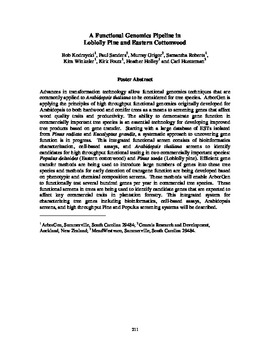| dc.contributor.author | Kodrzycki, B. | |
| dc.contributor.author | Sanders, P. | |
| dc.contributor.author | Grigor, M. | |
| dc.contributor.author | Roberts, S. | |
| dc.contributor.author | Winkeler, K. | |
| dc.contributor.author | Foutz, K. | |
| dc.contributor.author | Holley, H. | |
| dc.contributor.author | Huetteman, C. | |
| dc.date.accessioned | 2016-04-25T19:36:07Z | |
| dc.date.available | 2016-04-25T19:36:07Z | |
| dc.date.issued | 2003 | |
| dc.identifier | oksd_sf27_p211.pdf | |
| dc.identifier.citation | Kodrzycki, B., Sanders, P., Grigor, M., Roberts, S., Winkeler, K., Foutz, ... & Huetteman, C. (2003). "A Functional Genomics Pipeline in Loblolly Pine and Eastern Cottonwood." In 27th Southern Forest Tree Improvement Conference, Stillwater, OK | |
| dc.identifier.uri | https://hdl.handle.net/11244/33702 | |
| dc.description.abstract | Advances in transformation technology allow functional genomics techniques that are commonly applied to Arabidopsis thaliana to be considered for tree species. ArborGen is applying the principles of high throughput functional genomics originally developed for Arabidopsis to both hardwood and conifer trees as a means to screening genes that affect wood quality traits and productivity. The ability to demonstrate gene function in commercially important tree species is an essential technology for developing improved tree products based on gene transfer. Starting with a large database of ESTs isolated from Pinus radiata and Eucalyptus grandis, a systematic approach to uncovering gene function is in progress. This integrated functional screen consists of bioinformatics characterization, cell-based assays, and Arabidopsis thaliana screens to identify candidates for high throughput functional testing in two commercially important species: Populus deltoides (Eastern cottonwood) and Pinus taeda (Loblolly pine). Efficient gene transfer methods are being used to introduce large numbers of genes into these tree species and methods for early detection of transgene function are being developed based on phenotypic and chemical composition screens. These methods will enable ArborGen to functionally test several hundred genes per year in commercial tree species. These functional screens in trees are being used to identify candidate genes that are expected to affect key commercial traits in plantation forestry. This integrated system for characterizing tree genes including bioinformatics, cell-based assays, Arabidopsis screens, and high throughput Pine and Populus screening systems will be described. | |
| dc.format | application/pdf | |
| dc.language | en_US | |
| dc.relation.ispartofseries | Sponsored publication . . . of the Southern Forest Tree Improvement Committee ; no. 49 | |
| dc.rights | This paper is made available through open access and the auspices of the fair use doctrine for scholarly, educational and research purposes while recognizing the publisher already offers a free online version. The OSU Library�s intent is to offer access and preserve publications involving its faculty contributions. Contact the Digital Resources and Discovery Services at lib-dls@okstate.edu or 405-744-9161 for the permission policy on the use, reproduction or distribution of this material. | |
| dc.source | Proceedings of the 27th Southern Forest Tree Improvement Conference, volume 27, 2003. Editor, Craig R. McKinley. | |
| dc.title | Functional Genomics Pipeline in Loblolly Pine and Eastern Cottonwood | |
| dc.type | text | |
| osu.filename | oksd_sf27_p211.pdf | |
| dc.type.genre | Conference proceedings | |
| dc.description.scopeandcontents | Papers and abstracts from the 27th Southern Forest Tree Improvement Conference held at Oklahoma State University in Stillwater, Oklahoma on June 24-27, 2003. | |
